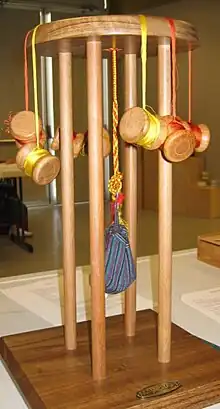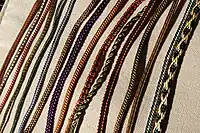
A marudai (丸台, lit. 'round stand') is the most common of the traditional frames used for making kumihimo, a type of Japanese braid.[1]
Etymology
The marudai is generally made of a close-grained wood and consists of a round disk (kagami or "mirror")[1] with a hole in the center, supported by four legs set in a base. The Japanese style marudai is often about 16 in (41 cm) high and is used while kneeling or when placed on a table. The Western style 26 in (66 cm) marudai allows the braider to sit in a chair to braid.
The warp threads that form the braid are wound around weighted bobbins called tama (lit. 'egg').[1] Tama were once made of clay, but now are most commonly wood filled with lead. The weight of the tama maintains even tension on the warp threads, and is balanced by a bag of counterweights called omori[1] that is attached to the base of the braid.
Modern braiders often replace the marudai with a foam disk with numbered slots that tightly grip the warp threads to maintain warp tension, so that weighted bobbins are not needed; instead, flexible plastic bobbins are used to prevent tangling of the threads. Unlike kumihimo disks, marudai have no indication of where the thread should be placed; it is done freehand.
Related terms
- Kagami – "Mirror", the polished wooden top disk of the marudai.[1]
- Kongō Gumi – a class of patterns for round cord all involving eight threads folded in half for a total of sixteen strands. In clockwise order, each bobbins is moved to the opposite side. When different combinations of thread color are used, many interesting patterns emerge, including diagonal stripes, diamonds on a background, triangles resembling hearts, and tiny six-petalled flowers. Kongō Gumi is named for the venerable Kongō Gumi company of Japan, the oldest known company in the world.
- Kumihimo or kumi himo – Japanese for "gathered threads".
- Obi – the broad cloth sash worn with kimono; kumihimo braids are often used as obijime, worn on top of the obi.
- Obijime – the cord used to fasten the obi securely in some obi styles. Usually one string of kumihimo is tied around the obi securely, and an accessory called the obidome is often added in front for decoration.
- Omori – Counterweights used in kumihimo braiding.[1]
- Takadai – a rectangular or square frame for kumihimo.
- Tama – little spools. The thread is kept from unwinding by passing the thread under itself, forming a loop around the tama.
- True silk – a hollow fiber with a rough surface that resists slipping past the loop unless gently pulled. For synthetic fibers, a flexible plastic "clamshell" bobbin may be preferable.


Further reading
- Yamaoka, Kazuharu Issei. (1975) Domyo no kimihimo : marudai, yotsu-uchidai [Domyo style kumihimo]. Tokyo : Shufunotomo Publication (Handicraft series). OCLC 703820275, JPNO 75076336 (in Japanese)
- Kyōto Kimono Gakuin. (1979) A Step to kimono and kumihimo. Pasadena, Calif: International College of California. OCLC 5658813.
- Carey, Jacqui. (1994) Creative Kumihimo. Torquay: Devonshire Press. ISBN 0952322501, 9780952322504, OCLC 888120089.
- Tada, Makiko. (1996) Andesu No Kumihimo: Kādo to Marudai. [Andean sling braids]. (Kumihimo sōran series, 2) Hino : Tekusuto. 2nd ed., (in Japanese) with some English. ISBN 4925252127, 9784925252126, OCLC 977659717 .
- Carey, Jacqui. (1997) The Craft of Kumihimo. New York: Midpoint Trade Books, In. ISBN 9780855328283, 0855328282, OCLC 903504434.
- Carey, Jacqui. (1997) Beginner's Guide to Braiding, the Craft of Kumihimo. Tunbridge Wells : Search Press. ISBN 0855328282, 9780855328283, OCLC 472775122
- Tada, Makiko (2008). Tada Makiko Kumihimo-ten : dento no bi to sentan gijutsu [Makiko Tada kumihimo show : traditional beauty and the latest technics]. Naruse Memorial Hall (ed). Tokyo : Japan Women's College (Tsukuru series 5). NCID BB19346894. (in Japanese)
- Sakai, Aiko ; Tada, Makiko. E o mite wakaru kumihimo : Tanoshiku dekiru marudai kakudai ayadake-dai [Visual guide to kumihimo : practice on marudai, kakudai, and ayadake-dai with fun], Japan Vogue, OCLC 676423318. (in Japanese)
- Owen, Rodrick. (1995) Braids: 250 Patterns from Japan, Peru & Beyond. Loveland, Colo. : Interweave Press, ISBN 1883010063, 9781883010065, OCLC 31754981. Softcover ed., Berkeley, CA : Lacis, 2004. OCLC 79431006
- Tada, Makiko. (April 2014) Marudai braids 120.(Comprehensive treatise of braids 1), 3rd ed., Hino : Tekusuto. (in Japanese) with some English. OCLC 676423383
- Chottikampon K.; Mathurosemontri S.; Marui H.; Sirisuwan P.; Inoda M., et al. (2015) Comparison of braiding skills between expert and non-experts by eye’s movement measurement. Lecture Notes in Computer Science (including subseries Lecture Notes in Artificial Intelligence and Lecture Notes in Bioinformatics) 9184 (2015): 14-23 ISSN 0302-9743, OCLC 5932476964
- Tada, Makiko. (2017). Utsukushii kumihimo to komono no reshipi: marudai de tsukuru honkakuteki na kumihimo o mijika na dōgu de yasashiku kawaiku. [Beautiful kumihimo recipes for marudai you braid with everyday tool, fun and pretty] Tōkyō : Nihon Bungeisha. ISBN 9784537214901, 4537214902, OCLC 995846156. (in Japanese)